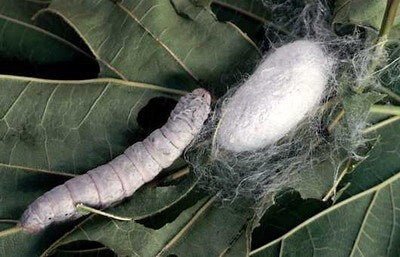Silk was considered an absolute for many centuries luxury product. Only aristocrats and other rich people could afford this noble fabric, which was initially only imported from China. The art of silk production was already known there 5000 years ago.
This process is now widespread around the world and silk is no longer reserved for a specific section of the population.
But natural silk is still not cheap and can't be produced arbitrarily, because it has a small animal supplier who wants to be well taken care of so that he can spin the thread for our silk with diligent work.

It is the silkworm, the larva of the silk moth, also known as the mulberry moth, to which we owe the fine natural fiber. For many centuries, these caterpillars have been bred to a level of perfection that yields both quantitative and qualitative yields. After hatching from the egg, it takes around 30 to 35 days for the caterpillar to grow and begin pupating.
Silk at the discounter?
During this month she molts up to four times a day and eats and eats and eats. From birth to pupation, she consumes 40,000 times her own body weight in mulberry leaves. She won't eat anything else and that of course makes breeding more difficult and that's probably the reason why real silk blouses or silk dresses are still not available cheaply at the discount store around the corner.
When the caterpillar is fully grown, its spinning glands become active and it secretes a protein substance that hardens into a thread when exposed to the air. The caterpillar wraps it around itself again and again by moving its head until a firm, elongated cocoon has formed. If you let nature take its course, the butterfly (silk moth) will hatch after eight to 14 days and the cocoon will disintegrate. But that's exactly what you prevent by collecting the cocoons and killing the caterpillars with heat. Then, after an outer layer of tangled fibers has been removed by brushing, a silk thread can be unwound, which can be up to 4000 meters long.
The fine threads obtained in this way are combined into several, depending on how strong the silk thread should be, which is then processed further. First of all, you are dealing with raw silk, which is not shiny and not very supple. The adhesive (silk glue, sericin) is then removed by boiling in soapy water and the silk thread begins to shine. Then it is wrapped, spooled, woven - our fine silk fabrics are created, which through dyeing become beautiful starting materials for our The blouse and Dresses will.
Silk is therefore an absolutely natural product made from animal fibers and therefore always contains small irregularities.
Silk "breathes", it cools pleasantly in winter and warms in summer and feels wonderful on the skin. But it is also sensitive and does not tolerate contact with perfume and skin care products, nor does it tolerate strong sunlight. Silk products should only be cleaned by hand, lukewarm and with special detergents. Do not wring out too much, let it dry flat and please iron gently inside out. However, before washing, be sure to take a look at the care label to see if the garment may not only have to be dry cleaned. So go gentle and mindful with hers silk blouses and silk dresses so that you can enjoy them for a long time.

